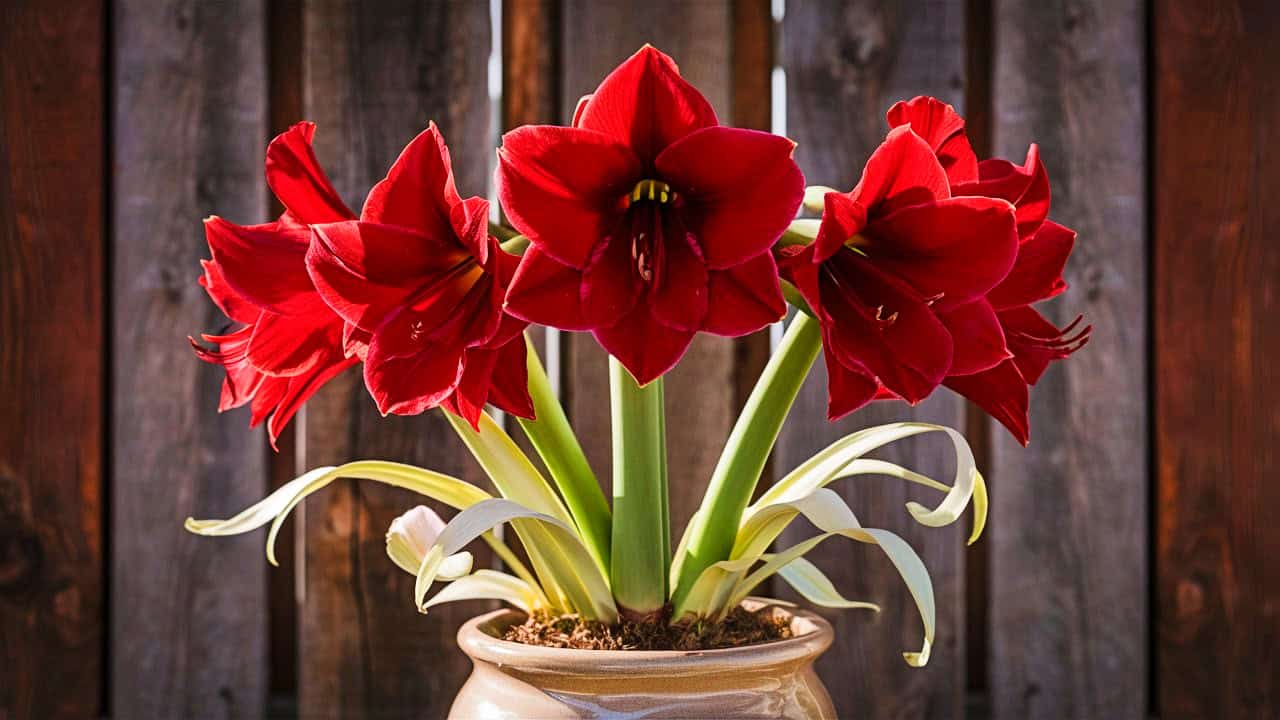One of the most delightful ways to cultivate amaryllis is by planting them in pots. This method offers flexibility, convenience, and the ability to enjoy their captivating blooms up close. In this comprehensive guide, we will explore the step-by-step process of growing amaryllis in pots, from selecting the right containers to caring for the plants and enjoying a beautiful display of vibrant blossoms.
Selecting the Right Pot
Size and Depth
Choosing a pot for amaryllis begins with selecting the appropriate size. An ideal pot should be between 6 to 8 inches in diameter. This size is sufficient to accommodate the bulb’s roots and provides ample space for growth. Considering the depth of the pot is equally important; it should be at least 6 to 8 inches deep. This depth ensures that the roots can spread out properly, providing stability and support for the tall flower stalks that amaryllis produce.
Drainage
Proper drainage is crucial when growing amaryllis in pots. Ensure the pot you choose has drainage holes at its base. These holes are essential to help excess water escape, preventing waterlogging — a common issue that can lead to bulb and root rot. If your pot lacks drainage holes, consider drilling some or using a liner with holes, as adequate drainage is foundational to healthy amaryllis growth.
Material
The material of the pot can affect the health of the amaryllis as well. Pots made from clay or ceramic are particularly popular for their aesthetic appeal and stability. Clay pots are porous, allowing for good air circulation around the roots. However, they do tend to dry out more quickly. Plastic pots, on the other hand, retain moisture longer and are lighter and easier to handle. Choose a material that complements your environmental conditions and aesthetic preferences.
Aesthetics
The visual appeal of the pot should not be overlooked, especially if you plan to place the potted amaryllis in a prominent indoor or outdoor spot. Select a decorative pot that enhances the beauty of the flowering plant. The right container can transform an amaryllis display into a focal point in your home or garden.
Planting the Amaryllis Bulb
Potting Mix
A well-draining, nutrient-rich potting mix is crucial for growing amaryllis. It’s best to use a mix specifically formulated for bulbs or indoor plants. Such mixes often contain perlite, vermiculite, or coarse sand to improve aeration and moisture retention. Avoid heavy garden soils that can compact and hinder root development.
Positioning the Bulb
When planting the bulb, place it in the pot so that one-third to one-half of it remains above the soil line. This positioning ensures that the bulb’s neck is exposed, which is essential for proper flower stalk development. Filling the pot with soil around the bulb without covering it completely helps maintain the right balance between oxygen and moisture.
Soil Firmness
Gently firm the soil around the bulb to provide stability without compacting it too much. Loose, well-aerated soil allows the roots to spread easily and access the necessary nutrients. Compacting the soil too tightly can restrict root growth and lead to poor plant health.
Watering
After planting, water the pot thoroughly until water drains out of the bottom. This initial watering helps settle the soil and removes air pockets around the bulb. Once new growth appears, maintain a consistent watering schedule, ensuring the soil is kept lightly moist but not waterlogged. Overwatering is a common cause of bulb and root rot.
Caring for Amaryllis in Pots
Light and Temperature
Amaryllis plants thrive in bright, indirect light. Place the potted bulb in a location that receives plenty of indirect sunlight, such as near a south- or east-facing window. Under artificial lighting, ensure the plant gets about 14 to 16 hours of light daily. The ideal temperature range for amaryllis is between 65 to 75°F (18 to 24°C). Maintaining these conditions supports robust growth and flower development.
Watering Schedule
Regular watering is essential for amaryllis once it begins to grow. Keep the soil consistently moist but avoid overwatering. A good rule of thumb is to water when the top inch of soil feels dry to the touch. Water deeply, allowing excess to drain out, and empty the saucer under the pot to prevent standing water, which can cause root rot.
Fertilization
Fertilization supports the health and flowering of amaryllis. Use a balanced, water-soluble fertilizer every 4 to 6 weeks during the growing season. A fertilizer with equal parts nitrogen, phosphorus, and potassium (such as a 10-10-10 formula) works well. Follow package instructions for dilution rates, and avoid over-fertilizing, as excessive nutrients can stress the plant and reduce bloom quality.
Supporting Flower Stalks
Amaryllis plants are known for their tall, robust flower stalks, which can sometimes become top-heavy and prone to bending or breaking under the weight of the blooms. Here are several ways to support these magnificent flower stalks:
Staking: Insert a stake into the soil near the bulb without damaging the roots. Choose stakes made from bamboo, plastic, or metal. As the flower stalk grows, gently tie it to the stake using soft ties or plant clips to provide support and stability.
Circular Supports: Consider using a circular plant support that surrounds the entire plant. This is particularly useful for larger amaryllis varieties that produce multiple flower stalks. The circular support provides an even distribution of support and helps keep the flowers upright.
Location: Placing the pot in a sheltered location can also help prevent wind or accidental bumps from damaging the flower stalks. Indoors, choose a spot away from high-traffic areas, and outdoors, consider placing it against a wall or among other plants that can provide natural support.
After-Blooming Care
Caring for amaryllis doesn’t stop after the initial stunning display of blooms. Proper after-blooming care ensures that the plant remains healthy and can bloom again in the following years.
Deadheading
Once the flowers fade and start to wilt, it’s essential to remove them to direct the plant’s energy back into the bulb for next year’s bloom. Use clean, sharp scissors or pruners to snip off the spent flowers, but leave the flower stalks to die down naturally.
Continued Care
Continue to water and fertilize the amaryllis regularly after blooming. The plant will continue to produce leaves, which are crucial for photosynthesis. This process converts sunlight into energy, which is stored in the bulb for the next blooming cycle. Ensure the plant gets sufficient light and nutrients throughout this period.
Dormancy Period
Amaryllis requires a dormant period to induce blooming. In late summer or early fall, reduce watering gradually to allow the plant to enter dormancy. When the leaves turn yellow and wither, trim them back to about 2 inches above the bulb. Move the pot to a cool, dark place (50-55°F / 10-13°C) for about 8 to 10 weeks. During this dormancy period, keep the soil barely moist.
Troubleshooting Common Issues
Despite being relatively easy to grow, amaryllis plants can face several challenges. Here’s how to troubleshoot common issues:
Yellowing Leaves
Yellowing leaves can be a sign of overwatering. To address this:
Reduce the frequency of watering and ensure the soil has good drainage.
Check for proper pot drainage and avoid letting the pot sit in standing water.
If overwatering persists, consider re-potting with fresh, well-draining soil mix.
No Flowering
If your amaryllis is not flowering, it could be due to several reasons:
Insufficient Light: Ensure the plant gets enough indirect sunlight. Move it to a brighter location if necessary.
Improper Dormancy: Forcing dormancy is crucial. Ensure the plant has a dormant period of 8 to 10 weeks in cool, dark conditions.
Nutrient Deficiency: Regular fertilization during the growing period is essential. Use a balanced fertilizer to provide the necessary nutrients.
Pests and Diseases
Amaryllis can be affected by pests such as aphids, spider mites, and mealybugs, as well as fungal diseases like leaf scorch and bulb rot.
Pests: Inspect the plant regularly and treat infestations with insecticidal soap or neem oil. Isolate affected plants to prevent the spread to other plants.
Diseases: Avoid overwatering and ensure good air circulation around the plant. If you notice signs of rot or fungal infection, remove affected parts and treat with a fungicide if necessary.
Re-blooming Amaryllis
Getting an amaryllis to re-bloom can be highly rewarding and involves proper care through all stages, including the dormant period. Here are some tips to encourage re-blooming:
Post-bloom Care: Continue regular watering and fertilizing after the initial bloom cycle.
Dormancy: Allow the plant to go dormant by reducing watering and providing a cool, dark resting period.
Reviving the Bulb: After the dormant period, bring the pot back to a warm, well-lit area. Resume regular watering and fertilization to stimulate new growth and eventual blooming.
Enjoying the Blooms
Amaryllis plants are celebrated for their dramatic and vibrant blooms that last for several weeks. Their large, trumpet-shaped flowers come in a variety of colors such as red, pink, white, and striped varieties, providing a striking display that brightens any space. Here’s how to make the most out of your amaryllis blooms:
Display: Place the blooms in a focal area where they can be admired. Indoors, a sunny windowsill, dining table centerpiece, or an entryway spot makes a perfect display area for showcasing the stunning flowers.
Cut Flowers: Amaryllis blooms make excellent cut flowers. If you decide to use them in a floral arrangement, cut the stems at an angle while they are still in bud. They will continue to open and last for up to two weeks in a vase with fresh water.
Bouquet Arrangement: Combine amaryllis with complementary flowers and greenery for a beautiful bouquet. Their large blooms pair well with smaller flowers like baby’s breath, roses, and ferns.
Seasonal Blooms
One of the unique aspects of growing amaryllis is the ability to manipulate their blooming period. With careful planning, you can time your amaryllis to bloom for specific holidays or events:
Christmas Bloom
Amaryllis is a popular choice for Christmas blooms. To achieve this, plant the bulb around mid-October. Given the average 6-8 week period from planting to blooming, this timing ensures that vibrant flowers grace your home during the festive season.
Valentine’s Day Bloom
For a glorious display of amaryllis for Valentine’s Day, consider planting the bulbs in early December. The striking red or pink blooms make a perfect romantic gift or table centerpiece.
Easter Bloom
By planting amaryllis bulbs in January, you can enjoy their vibrant blooms around Easter. This timing works well to bring a fresh, colorful touch to your holiday decor, symbolizing new beginnings.
Varieties of Amaryllis
Amaryllis comes in a range of varieties, offering different colors, sizes, and bloom shapes. Here are a few popular types:
Hippeastrum ‘Red Lion’: Known for its large, deep red blooms, this variety is a classic favorite during the holiday season.
Hippeastrum ‘Apple Blossom’: Featuring soft pink and white petals, ‘Apple Blossom’ offers a delicate and elegant appearance perfect for spring.
Hippeastrum ‘Picotee’: This variety has pure white petals edged with a fine red line, creating a striking contrast and unique beauty.
Hippeastrum ‘Minerva’: Characterized by its bright red petals with a white star pattern in the center, ‘Minerva’ is a visually stunning choice.
Benefits of Growing Amaryllis
Growing amaryllis in pots not only provides aesthetic pleasure but also offers several practical benefits:
Flexibility: Growing amaryllis in pots allows you to move them easily, ensuring they receive the optimal light and temperature conditions.
Extended Blooming Period: By manipulating planting times and providing the appropriate care, you can enjoy multiple blooming seasons per year.
Compact Space: Potted amaryllis plants are perfect for gardeners with limited space. They can thrive on windowsills, balconies, and small patios.
Easy Maintenance: Amaryllis requires minimal effort to grow. With proper watering, fertilization, and light conditions, they will reward you with stunning blooms.
Year-Round Enjoyment: With proper care, potted amaryllis can be encouraged to bloom throughout the year, creating a continuously refreshing and vibrant display.
Final Thoughts
Growing amaryllis in pots is a rewarding endeavor that allows you to enjoy these spectacular plants in a variety of settings, from indoor displays to outdoor garden spots. By following the step-by-step guide on selecting the right pot, planting the bulb, caring for the plant, and troubleshooting common issues, you can cultivate healthy and thriving amaryllis that will bring vibrant color and elegance to your space.
Whether you’re a seasoned gardener or a beginner, amaryllis offers a delightful gardening experience. Their stunning blooms, ease of care, and flexibility in growing conditions make them a favorite among plant enthusiasts. With thoughtful care and attention to detail, you can enjoy these magnificent flowers year after year, brightening your home with their enchanting beauty.
For those looking to explore further, consider expanding your collection with different varieties and experimenting with bloom timing to create a dynamic and ever-changing display of amaryllis flowers. Happy gardening!





